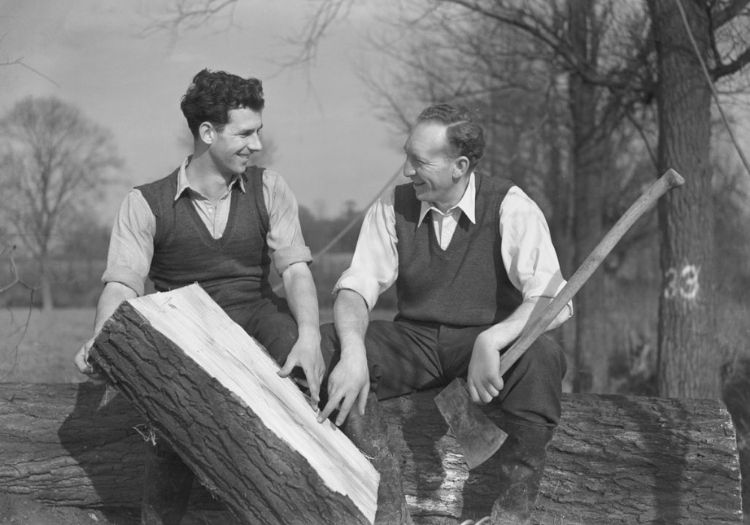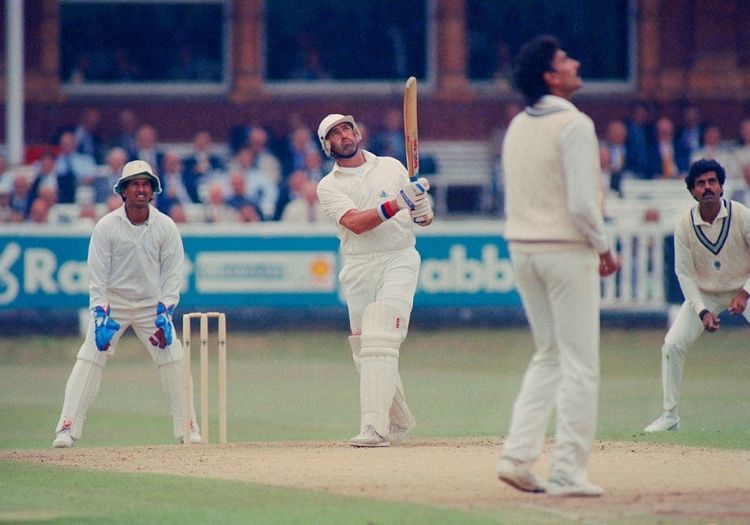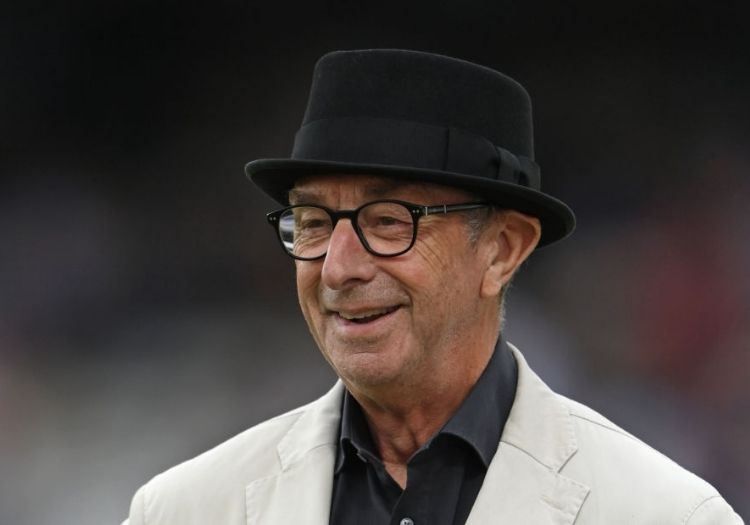HUW TURBERVILL tells the story of the super Surrey skipper who tailored mighty bats, including contributions with Graham Gooch and David Lloyd


Botham epic knocks and building the perfect bat: The Duncan Fearnley story
It was an advert on BBC TV that lasted 10 hours and 28 minutes. Crack, crunch, crash… bish, bash, bosh. Graham Gooch and his Stuart Surridge Turbo, hammering his way to 333 against India at Lord’s in 1990. The company could not have wished for greater exposure.
“That’s not a shot you’d expect Gooch to play in a Test at this stage of the match,” says Ray Illingworth, as the England captain went past 50. “Don’t bother looking for that, let alone chasing it,” says Richie Benaud, with Gooch, in the 300s, after he hammers a straight six. “It’s gone up into the building works.”
That innings signified that the SS was one of cricket’s iconic bats for this 17-year-old, and beefy innings played by Sir Viv Richards (who used the Perfect, then the Jumbo), Richie Richardson, Clive Rice and Lance Klusener, and fine knocks from Mark Taylor in his early years, sealed the deal.
David ‘Bumble’ Lloyd also used their Streaker, sadly before my time; and Frank Hayes, Lloyd’s Lancashire team-mate, used the SS ‘XXI’ with its extended 21-inch handle on his Test debut in 1973 against West Indies at The Kia Oval when he scored a century.
SS bats looked sturdy, robust, no-nonsense… stylish in their way, with a simple red and blue logo and livery.
I also marvelled at the Jumbo used by a teammate, who was a big unit at about 6ft 4ins and could hit the ball a long way (and bowl fast, at people’s noses). ‘The bigger they are, the harder they hit – the SS Jumbo – Bat of Choice’ was the marketing spiel.
SS bats endured for a while, and Gooch even started using a new 333 model, but like Duncan Fearnley cheaper Indian blades became dominant. In the early 1990s, the company even went to court in India over the use of the SS branding, which was – and still is – being used by Sareen Sports Industries. At least they had some good years, the bats an enduring celebration of a great cricketer and character.
At the time of writing there is one for sale on eBay, incorrectly labelled ‘grey nicolls (sic) cricket bat’, with a starting price of £40. Another is priced £80 and has a weight of 2lbs 15oz. Ouch.

Making and developing bats ran in the Surridge family
Captain Marvel
Stuart Surridge was 34 when he became one of the most successful captains the county game has known. It had taken him a long time to break into the Surrey team, as an amateur, but it was the captaincy that proved his greatest suit. He skilfully and adventurously juggled a gifted bowling line-up of his quicks Alec Bedser and Peter Loader, and spinners Jim Laker, Tony Lock and Eric Bedser, with extra seam from himself.
They also had a strong batting line-up that included Peter May and Micky Stewart, while Surridge was a hard-hitting tailender himself, and Surrey won the title in each of the five years he was skipper, from 1952 to 1956. He was also a fearless fielder who placed enormous emphasis on catching, and he was a Wisden Cricketer of the Year in 1953.
He had been born in Herne Hill in south London and went to Emanuel School in Clapham, but bat-making was in the blood – his grandfather Percy started a company repairing bats and received tuition from James Lillywhite – and he soon started learning the craft himself. The company was based at 175 Borough High Street, London, before moving to Witham, Essex, and they had connections with a willow farm in Aldermaston.
One of Percy’s bats had been the Rapid Driver, used by WG Grace, KS Ranjitsinhji, CB Fry and Don Bradman. They were notable for having reinforced toes.
Stuart’s son, Stuart Spicer Surridge, known as ‘Tiger’, took over the business. Now 69, he played one first-class match for Surrey, in 1978. Under him the company branched out into tennis, hockey and football. In 1989 they made the official Football League ball, the first synthetic lace-less model: called the UFO, it was used by Justin Fashanu for his famous goal for Norwich City against Liverpool in 1980. They also made snooker cues for Jimmy White.
The famous logo was introduced in the 1960s, and the Turbo was introduced in the 1980s.
Stuart Surridge Snr died in 1992, and the company was bought by Dunlop Slazenger. It was then sold on to a group of Indian and South African investors in 2000, before being purchased by The SDL Group, based in Burnley in 2003. They made kits for Surrey (fittingly), Durham, Derbyshire, Gloucestershire, Glamorgan, Leicestershire, Northamptonshire, Scotland and the Netherlands, and currently supply the county champions, Essex.
Charley Surridge, daughter of John Surridge, Stuart Snr’s nephew, is ensuring his legacy lives on, however, and has just started up a cottage industry: bats made by Swannack.
No doubt they will contain Stuart Surridge’s DNA, and the spirit of Gooch, lording it 31 years ago.

Gooch's marched to his imperious 333 using a Surridge blade
Graham Gooch
Stuart Surridge were locally based in Witham – although the family were in Clapham – and Stuart, or ‘Tiger’ as we knew him, gave me the chance potentially to stay with the company when I finished playing cricket. The contract was into the £1,000s. I expect they are in the 100s of 1000s now!
The bats had ash, hard edges on them, dark wood. I had a laminated bat for my 333: two pieces of wood glued together. A lot of quality pieces of wood had imperfections in them, so they couldn’t sell them as five-star willow, they had the occasional knot or whatever…
Tiger had the idea of cutting an inch-thick face and a back… they were both the same quality, glued together in cleft form. There was no difference in performance but the laminated bat lasted longer, it was much more durable. It wasn’t like two halves – it slotted together. If you get a crack in a normal bat that can go all the way through, and the bat is finished really. With a laminated bat the crack goes only halfway through. They were great for professionals, but not great for selling bats: they don’t mind them breaking as they want to sell new ones.
SS used to sell the exact replica of the 333, in terms of weight and feel. I used to personally sign the back of each bat which was a bonus for me because the ones I liked I put to one side – six to eight at a time.
They then sold the business to Slazenger, which is why I used their bats briefly at the end of my career. They wanted Surridge because of their connections with the willow farms at Aldermaston in Berkshire (3.5 miles from the RAF nuclear base, home of the Atomic Weapons Establishment).
SS also had a factory at Great Leighs in Essex. Jessie Samuel Wright started it up, and his sons took it on. Carleton was the one I worked with. We still walk through their willow farms sometimes – they pretty much have a monopoly on it. They also plant willows around all the ditches throughout East Anglia – they husband them for 15–20 years, they then pay farmers the commission.
There’s a pocket history for you!
The primary reason why the English manufacturers struggled is that it became cheaper to buy the clefts off JS Wright and ship them to India, make them, and bring them back here.
A cricket bat is a very personal thing. I can’t see how you can buy one off the internet. It’s one of those touchy-feely things. You need to pick it up, it needs to feel right in your hands. The right shape, everything about it. Especially if you are a pro. If you are standing there at the crease, holding that bat and gloves, and it doesn’t feel right, you have a problem. You are not focusing as you should be.

Lloyd was rarely seen without a Stuart Surridge in hand
David ‘Bumble’ Lloyd
Young Tiger approached me. Stuart Surridge were decent players in the kit market at the time.
Tiger lived life to the full, he was the mainstay of the business.
I always used their bats and was very happy with them.
I started with a 2lbs 4 oz, then went up to a 2.7, but it was never really to do with the weight – the pick-up was always the important thing.
I used a Streaker, with the ash edges. The idea was that it was harder than willow, but because it was glued in, it kept flying out and stabbing first slip!
My rep was in Altrincham, I can’t recall his name, which I’m sorry about. He’d give me about four at the start of the season, then more if I needed it.
I must confess that Duncan Fearnley did once make me a lovely bat, and I put SS stickers on it, but that was an exception.
There was a bit of a rumpus about my gloves. St Peter, who were used by Tony Greig, brought out these ‘mitts’.
SS did something similar, and they were mainly red. The committees didn’t like that. In those days there was trouble when the kits, especially boots, were not entirely white.
I was impressed at how SS broke into football. They faced some serious competition in Mitre. I remember playing with ‘the Cobbler’ ball.
SS made bloody good kit.
Subscribe today and receive The Cricketer’s centenary issue – six issues for £19.21. Click here
Subscribe to The Cricketer for exclusive content every day: The inside track on England's Test tour with George Dobell in Pakistan, award-winning analysis, breaking news and interviews and the only place for in-depth county coverage all year round. Plus: An ad-free app experience at your fingertips. Subscribe to thecricketer.com today for just £1.